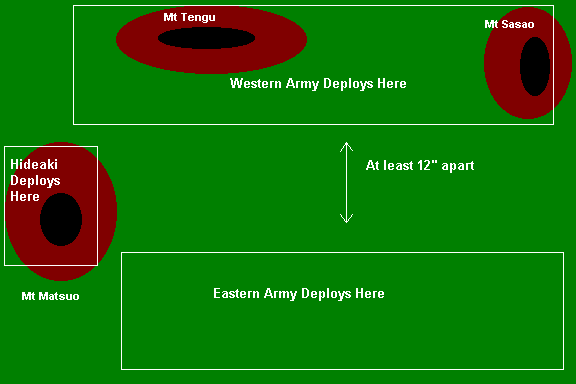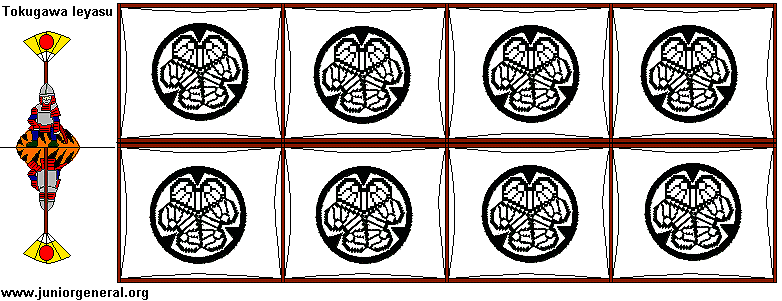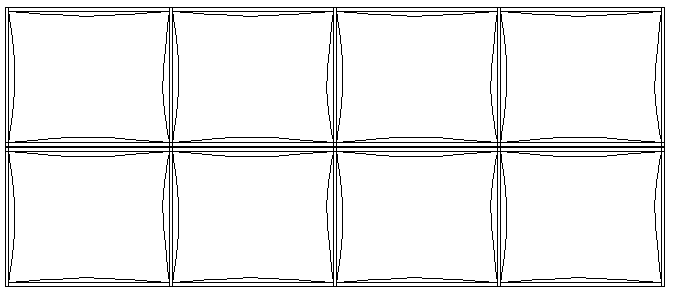 Historical Background:
The Sengoku or "Warring States" period of Japanese history lasted from 1467 - 1615 AD. During this time warlords and their samurai armies waged civil war. In 1590 Toyotomi Hideyoshi succeeded in uniting Japan under his rule. After his death there was a power struggle between a coalition of Eastern clans led by Tokugawa Ieyasu and a Western coalition led by Ishida Mitsunari. Their final showdown occured near the town of Sekigahara in 1600 AD. The armies were evenly matched. Mitsunari deployed his army to block the vital Nakasendo road, with Kobayakawa Hideaki's large clan in position to threaten the Eastern army's left flank. However Hideaki had secretly promised Ieyasu that he would switch sides once the battle started.
Historical Background:
The Sengoku or "Warring States" period of Japanese history lasted from 1467 - 1615 AD. During this time warlords and their samurai armies waged civil war. In 1590 Toyotomi Hideyoshi succeeded in uniting Japan under his rule. After his death there was a power struggle between a coalition of Eastern clans led by Tokugawa Ieyasu and a Western coalition led by Ishida Mitsunari. Their final showdown occured near the town of Sekigahara in 1600 AD. The armies were evenly matched. Mitsunari deployed his army to block the vital Nakasendo road, with Kobayakawa Hideaki's large clan in position to threaten the Eastern army's left flank. However Hideaki had secretly promised Ieyasu that he would switch sides once the battle started.
The Eastern army launched a determined attack and made good progress. Slowly the Western army drove them back and began to counterattack. Mitsunari and Ieyasu both tried to convince Hideaki to intervene on their side. Finally he made his decision and charged down the hill right into the flank of the Western army. His betrayal was decisive, and the Western army was routed. In the years following the battle Ieyasu was able to consolidate his power and become the Shogun of Japan.
The Tokugawa Shogunate would last last until 1868, a time marked by peace, a strict caste system, and isolation from the outside world.
Battle 1:
This battle has not yet been playtested.
The Miniatures:
The figures used were 1/72-scale plastics from Zvezda Samurai Infantry and Samurai Cavalry. The infantry were mounted with two figures on bases 1.5" wide by .75" deep. Samurai cavalry units included retainers on foot, so the Cavalry bases were 1.5" square and included one mounted and one foot figure. Clan leaders led from horseback, they were mounted on bases 1.5" x 7.5". Some paper soldiers are included which you can print and use.
Formations:
Infantry and cavalry units have six stands (double rank line).
Order of Battle:
This is a simplified order of battle, combining some smaller clans into larger formations, and including only some of the clan leaders. I included equal numbers of archers and arquebusiers because that was the mix in the Zvezda boxes. Historically the arquebusiers would have been more numerous. If you want a more detailed OB check out the resources at the end for some sources.
- Eastern Army
Tokugawa Ieyasu (Overall Commander)
- Kuroda Nagamasa
1 unit cavalry
1 unit foot samurai
1 unit arqubusiers
2 units ashigaru spearmen
Fukushima Masanori
1 unit cavalry
1 unit foot samurai
1 unit arqubusiers
2 units ashigaru spearmen
Ii Naomasa
1 unit cavalry
1 unit foot samurai
1 unit arqubusiers
2 units ashigaru spearmen
Hosokawa Tadaoki
1 unit cavalry
1 unit foot samurai
1 unit arqubusiers
2 units ashigaru spearmen
Kyoguku Takatomo
1 unit cavalry
1 unit foot samurai
1 unit arqubusiers
2 units ashigaru spearmen
Honda Tadatsugu
1 unit cavalry
1 unit foot samurai
1 unit arqubusiers
2 units ashigaru spearmen
Western Army
Ishida Mitsunari (Overall Commander)
- Shima Sakon
1 unit cavalry
1 unit foot samurai
1 unit arqubusiers
2 units ashigaru spearmen
Konishi Yukinaga
1 unit cavalry
1 unit foot samurai
1 unit arqubusiers
2 units ashigaru spearmen
Ukita Hideie
1 unit cavalry
1 unit foot samurai
1 unit arqubusiers
2 units ashigaru spearmen
Otani Yoshitsugu
1 unit cavalry
1 unit foot samurai
1 unit arqubusiers
2 units ashigaru spearmen
Oda Nobutaka
1 unit cavalry
1 unit foot samurai
1 unit arqubusiers
2 units ashigaru spearmen
Shimazu Yoshihiro
1 unit cavalry
1 unit foot samurai
1 unit arqubusiers
2 units ashigaru spearmen
Kobayakawa Hideaki (possible traitor)
1 unit cavalry
1 unit foot samurai
1 unit arqubusiers
2 units ashigaru spearmen
The Board:
A 7.5 X 5 foot table was used. There were several mountains, which can be represented by pieces of felt, or simply drawn with marker. There were two rivers and a road on the battlefield, but they had little effect on the outcome of the battle and were omitted.
Deployment:
The Eastern and Western armies deploy in the boxes indicated on the map. The archers and arquebusiers should be in front. Kobayakawa Hideaki and his army deploy on Mt. Matsuo, as indicated on the map.
Resources:
A search of the Internet, library, and Magweb (www.magweb.com), turned up some useful resources for wargaming Sekigahara
Sekigahara 1600: The Final Struggle for Power by Anthony J. Bryant, Osprey Campaign #40
Samurai Warfare by Dr. Stephen Trumbull
Battles of the Samurai by Dr. Stephen Trumbull
Samurai Armies 1550-1615 by SR Turnbull and Richard Hook, Osprey Men-at-Arms #86
"Sekigahara: Samurai DBA Battle" by Bill Boyle, MWAN # 104
The Battleground at Sekigahara, web page (hkuhist2.hku.hk/Nakasendo/sekigrnd.htm) by Thomas Stanley and RTA Irving
Flags of the World web site (flagspot.net/flags/index.html), has Daimyo flags from the 15th - 17th century


The Reluctant Samurai Battle of Sekigahara (1600)
Back to Table of Contents -- Junior General Report # 5
Back to Junior General Report List of Issues
Back to MagWeb.com Magazine List
© Copyright 2004 by Matt Fritz.
This article appears in MagWeb.com (Magazine Web) on the Internet World Wide Web. Other articles covering military history and related topics are available at http://www.magweb.com